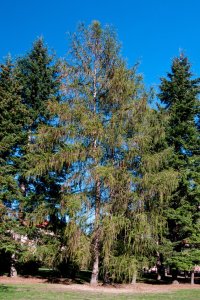
Larch deciduous (Larix decidua)

| Occurrence in Děčín |
The
oldest specimens grow in the North Castle Park, Kvádrberk Arboretum, and also
occur in Libverda BZ, cemeteries and many other parks and gardens. |
| Application |
In
orcharding and landscaping it is versatile to use in groups as well as solitaire.
Well suited for contrast on dark background of other conifers. The greatest
effect is given at the time of sprouting and flowering, but especially in the
fall when the needles turn gold, and sometimes persists until the arrival of
the first fall of snow. It is more resistant to exhales than evergreen
conifers. |
| Habitat |
Occurs
naturally in mountainous locations along with beech or spruce. It is
light-loving, not demanding on the soil, can withstand drier and stony
exposures, but it does not tolerate waterlogging. |
| Location |
Occurs
in the mountains of Central Europe, especially in the Alps and the Carpathians.
Although it is known as the native domestic tree, it occurs naturally only in
the Low Jeseník, and still in a race called Sudeten larch with shorter
pinecones. |
| Wood |
Provides
high-quality, hardwood that is orange to red. |
| Fruits |
Cones are 2-6cm
long, reddish brown, ripe ocher faded, scales at the edges uniformly rounded or
shallowly cut, generally straight, curved only slightly at the bottom. Cones
are the most reliable cognitive feature. |
| Blossom | Ovate to spherical, 5-10 mm long, sulfur yellow, pollen released in March to May. Ené upright, ovate, 1-1.5 cm long, pink to dark red. |
| Leaves |
Needles: Grow
from short twigs called brachyblasts of 30-40, they are 15-30mm long, thin,
light green, flat on the upper side, hernia at the bottom, autumn color is
light to golden yellow. |
| Branches |
Young
shoots are thin, pale yellow, glabrous, loose overhang. |
| Rind |
Bark
in the youth smooth and gray, thick in the old trees, gray-to-red-gray, dark,
longitudinally furrowed. |
| Treetop |
Up to
40 (50) m tall tree with crown initially conical, later loosened, irregularly
flattened, branches horizontal, lower can be inclined. Old trees can reach
trunk strength of up to 1.5m. |
| Note |
There is a remarkable specimen in the courtyard of the
upper castle in Benešov nad Ploučnicí. The strongest larch in the Czech
Republic grows in nearby Petrovice, where it can be found near the border
crossing to Germany (it is 550cm wide, and is very bizarre in shape). The
world's largest deciduous larch grows in Prairior (Vallese), Switzerland, where
it grows into a monumental perimeter of 1120cm. |





